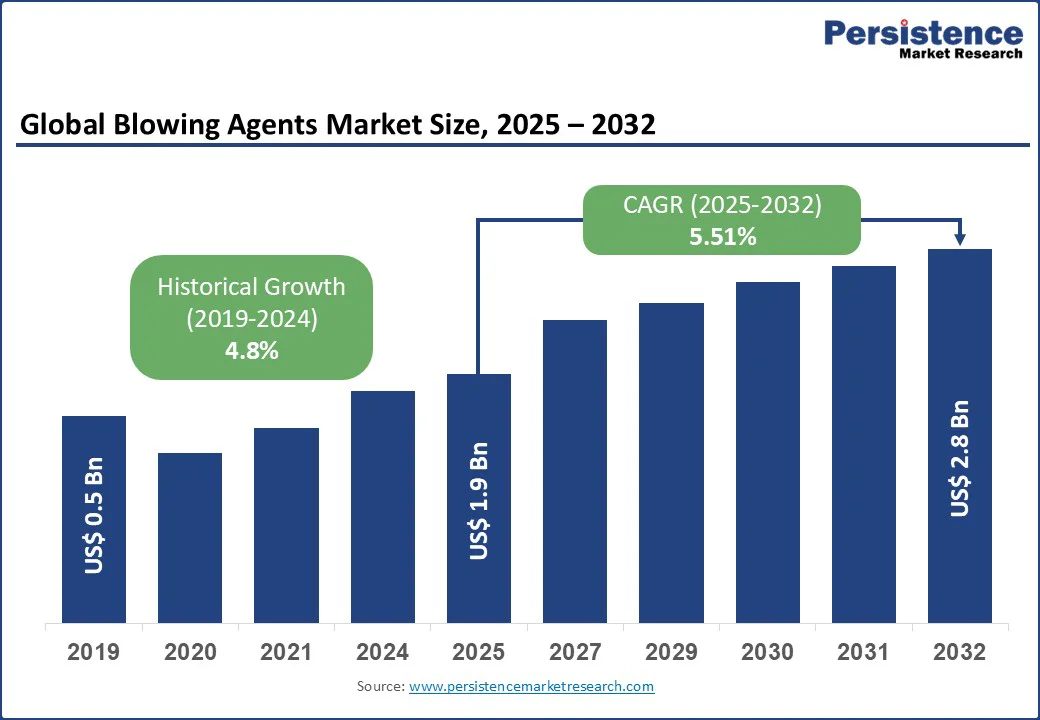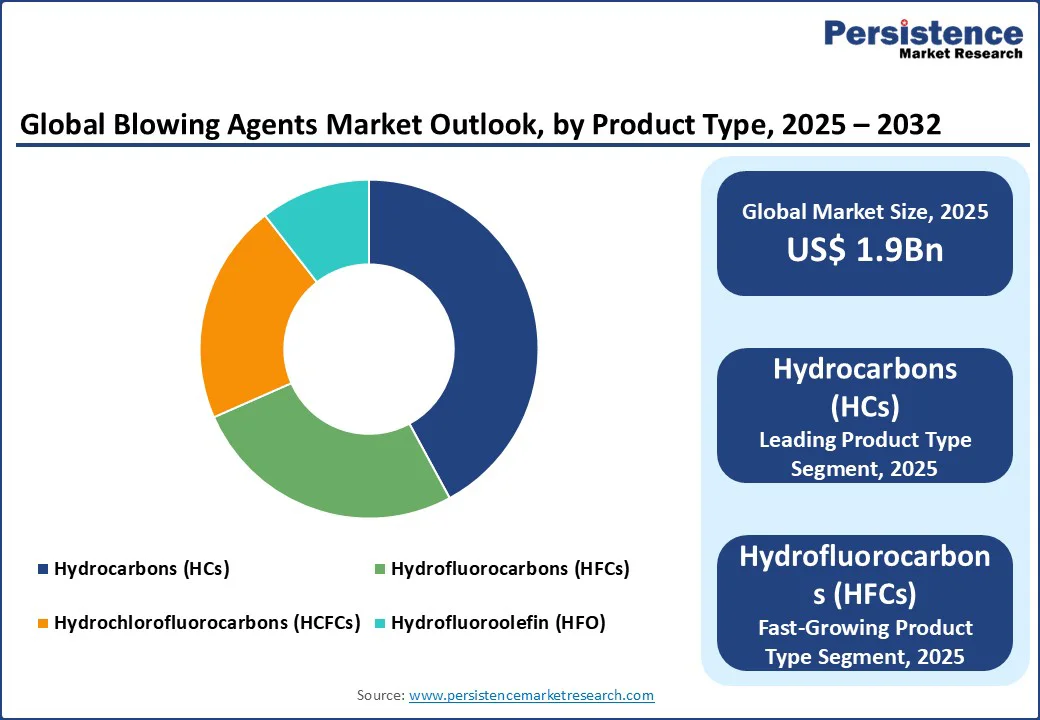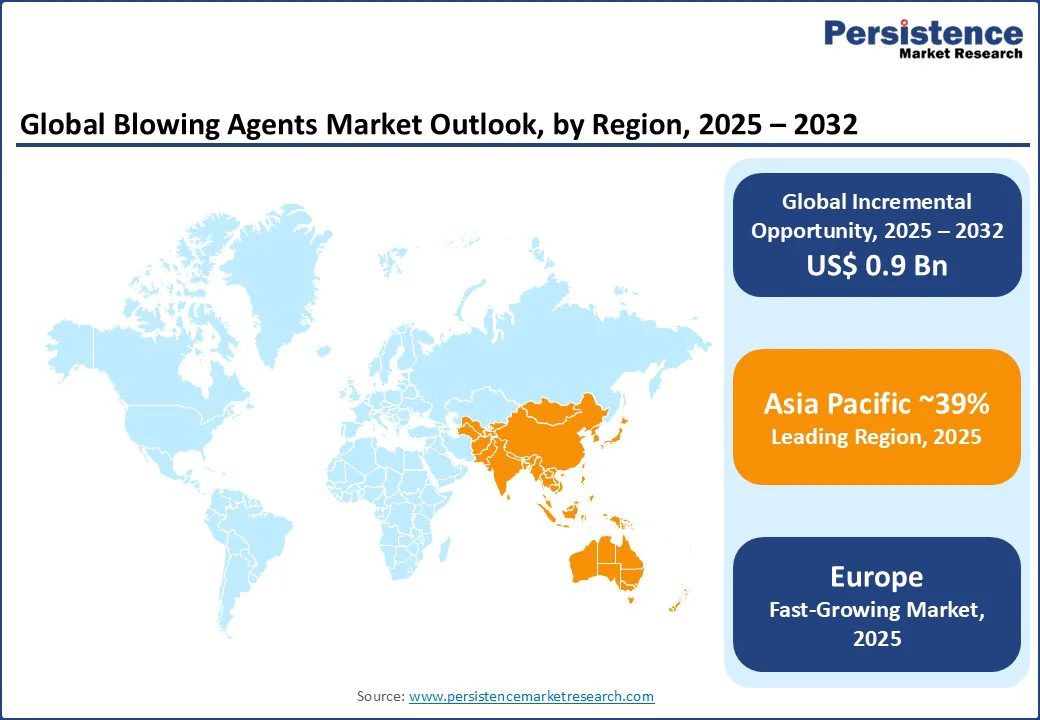ID: PMRREP5228| 0 Pages | 19 Sep 2025 | Format: PDF, Excel, PPT* | Chemicals and Materials

The global blowing agents market size is likely to be valued at US$1.9 Bn in 2025 and reach US$2.8 Bn by 2032, growing at a CAGR of 5.51% during the forecast period from 2025 to 2032, driven by increasing demand for lightweight, energy-efficient, and sustainable materials across industries such as construction, automotive, and packaging. Blowing agents, critical for producing cellular structures in foams, enhance insulation, reduce material density, and improve product durability.
Key Industry Highlights:

| Key Insights | Details |
|---|---|
|
Blowing Agents Market Size (2025E) |
US$ 1.9Bn |
|
Market Value Forecast (2032F) |
US$ 2.8Bn |
|
Projected Growth (CAGR 2025 to 2032) |
5.51% |
|
Historical Market Growth (CAGR 2019 to 2024) |
4.8% |
The global blowing agents market is experiencing significant growth due to the rising demand for energy-efficient insulation materials in the construction industry. Blowing agents are critical in producing polyurethane and polystyrene foams, which are widely used for thermal insulation in buildings, reducing energy consumption and greenhouse gas emissions. According to the International Energy Agency, global energy demand for heating and cooling in buildings is expected to rise by 40% by 2040, necessitating advanced insulation solutions.
In the Asia Pacific, China’s 14th Five-Year Plan prioritizes green building initiatives, driving demand for eco-friendly blowing agents, such as HFOs. In the U.S., the Department of Energy reported that energy-efficient insulation could reduce building energy costs by up to 11%. Companies such as Honeywell and Arkema have seen increased sales of low-GWP blowing agents in 2024, reflecting the construction sector’s shift toward sustainability. Government-led energy efficiency mandates and rising urbanization ensure sustained demand, positioning construction as a key driver for market growth through 2032.
The blowing agents market faces challenges due to stringent environmental regulations and high costs associated with developing eco-friendly alternatives. Regulations such as the Kigali Amendment to the Montreal Protocol mandate the phase-out of high-GWP blowing agents such as HFCs, pushing manufacturers to invest in costly R&D for low-GWP alternatives such as HFOs. In 2023, the cost of transitioning to HFO-based formulations increased production expenses for smaller players, limiting their competitiveness.
Additionally, the complexity of ensuring compatibility with existing foam production processes adds to development costs. Competition from alternative insulation materials, such as mineral wool, also poses a threat in cost-sensitive markets. These regulatory and cost-related challenges, particularly in developing regions with limited infrastructure, restrain overall market growth.
The increasing focus on renewable energy and electric vehicles (EVs) presents significant opportunities for the blowing agents market. Blowing agents are essential in producing lightweight foams for insulation and cushioning in EV battery systems and renewable energy infrastructure, such as wind turbine insulation.
The International Energy Agency projects global renewable energy capacity to increase by 2.7 times by 2030, with wind and solar projects driving demand for polyurethane foams. In the EV sector, blowing agents are used in manufacturing lightweight components to improve fuel efficiency.
Companies such as Solvay and The Chemours Company are innovating with HFO-based blowing agents for automotive applications, aligning with sustainability trends. The EU’s Green Deal and similar global initiatives encourage investments in green technologies, creating opportunities for manufacturers to develop advanced, eco-friendly blowing agents to meet industry needs through 2032.

Asia Pacific is set to dominate in 2025, capturing a substantial 39% share due to its rapid industrialization, urbanization, and booming construction sector, particularly in China and India. China, recognized as a global manufacturing powerhouse, plays a pivotal role in foam production, fueled by government initiatives such as the 14th Five-Year Plan that prioritize energy-efficient buildings and sustainable development. This plan encourages the widespread adoption of advanced insulation materials, such as polyurethane foam, which relies heavily on blowing agents.
Similarly, India’s Smart Cities Mission promotes urban modernization with an emphasis on green infrastructure, driving significant demand for high-performance insulation solutions. Beyond construction, the packaging and automotive sectors in the Asia Pacific contribute notably to blowing agents consumption. Major companies such as Daikin and Arkema are expanding operations and investments in the region to meet growing demand. Additionally, heightened consumer awareness around environmental sustainability, coupled with supportive government policies and incentives for green technologies, reinforces Asia Pacific’s position as a leader through 2032.
Europe is emerging as the fastest-growing region, largely driven by stringent environmental regulations and an increasing demand for sustainable insulation materials in the construction sector. The European construction industry, valued at €1,683 billion in 2023 according to the European Construction Industry Federation, plays a critical role in this growth. As energy efficiency becomes a top priority, blowing agents are essential for producing high-performance insulation materials that reduce energy consumption and greenhouse gas emissions in buildings.
Germany and France are at the forefront of this demand, propelled by rigorous green building standards and ambitious renewable energy projects such as offshore wind farms. Leading chemical companies such as Solvay and BASF are innovating with hydrofluoroolefin (HFO)-based blowing agents, which have low global warming potential and comply with strict EU regulations such as the European Green Deal. These developments are expected to sustain robust market growth across Europe through 2032, as the region transitions towards a greener and more energy-efficient built environment.
North America stands as the second fastest-growing region, fueled primarily by strong demand from the construction and automotive industries in the U.S. and Canada. In July 2025, the region’s total construction spending reached an estimated $2,139.1 billion, reflecting sustained investments in both commercial and residential projects. Blowing agents play a crucial role in producing high-quality insulation materials that enhance energy efficiency and meet stringent building codes. In Canada, the automotive sector significantly contributes to market growth by driving demand for lightweight foam materials used in electric vehicle (EV) production, aligning with global efforts to reduce vehicle emissions.
Leading companies such as Honeywell and The Chemours Company dominate the market with extensive distribution networks and innovative product offerings. Their focus on low-global-warming-potential blowing agents caters to increasing energy efficiency mandates and growing consumer preference for sustainable materials.

The global blowing agents market is highly competitive and fragmented, with a mix of global and regional players. Leading companies, including The Chemours Company, Honeywell International Inc., Solvay, and Arkema, dominate through extensive product portfolios and global distribution networks. Regional players, such as CHEMSPEC Ltd., focus on localized offerings in the Asia Pacific. Companies are investing in eco-friendly blowing agents, such as HFOs, and advanced manufacturing technologies to enhance market share, driven by demand for sustainable foams in construction and automotive sectors.
The Blowing Agents market is projected to reach US$1.9 Bn in 2025.
Growing demand for energy-efficient insulation in construction and expanding applications in renewable energy and automotive sectors are key market drivers.
The Blowing Agents market is poised to witness a CAGR of 5.51% from 2025 to 2032.
Rising demand in the renewable energy and electric vehicle sectors is the key market opportunity.
The Chemours Company, Honeywell International Inc., Solvay, and Arkema are key market players.
| Report Attribute | Details |
|---|---|
|
Historical Data/Actuals |
2019 - 2024 |
|
Forecast Period |
2025 - 2032 |
|
Market Analysis |
Value: US$ Bn/Mn, Volume: As Applicable |
|
Geographical Coverage |
|
|
Segmental Coverage |
|
|
Competitive Analysis |
|
|
Report Highlights |
|
By Product Type
By Foam Type
By Application
By Region
Delivery Timelines
For more information on this report and its delivery timelines please get in touch with our sales team.
About Author